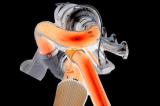- Replies 17
- Views 2.5k
- Created
- Last Reply
Top Posters In This Topic
-
Mopar1973Man 6 posts
-
JOHNFAK 5 posts
-
Haggar 3 posts
-
IBMobile 2 posts
Popular Days
Most Popular Posts
-
John, Slow movement on the vacuum could be two other things. Water in the system and bad vacuum pump. When you reach the proper pressure temperature balance, the pressure will stay const
-
John, You saw the low oil... darn was hoping that was it. (I have gotten bitten by that too many times to list.) Yes just test your rig sort of. Screw the low side to a valve you can c
-
How about dumping a can of this in?http://www.oreillyauto.com/site/c/detail/INTC/R134AUV12CA.oap?ck=Search_134a+with+uv_-1_2902&keyword=134a+with+uv






So its been winter here, and during this period my wife backed into front of my truck. Quite a lot of damage to hers, almost not a scratch on mine.
However summer is here an I go to put on AC and nada. So obvious thought is she damaged the AC condensor at front.
I black light everything - cant see anything from the previous dye..... might be too old.
I vacuum everything down. It goes from 28HG to around 25HG in around 4 hours. So must have a leak.
So then I primed with compressed air to 100psi through high with system open (means both sides at 100). Couldn't hear any leaks.
Sprayed with soapy water - that didn't do anything except make a mess of soapy water.
So I added some UV dye ...... and with the system still at 100 I started truck to try and get compressor to cycle and move some dye around and maybe see a leak.
Nothing ......(AC was cycling a few days back - just real often and not very cold).
So right now just a mess of dye, soapy water and still no idea of how to track down leak.
Surely there has to be a better way ....... ideas ??
*Side Note* When I started truck with 100psi in system the line between compressor and condensor got really hot. Obiously I never touch it under normal operation ....... so not sure how hot it gets ...... but seemed excessive.